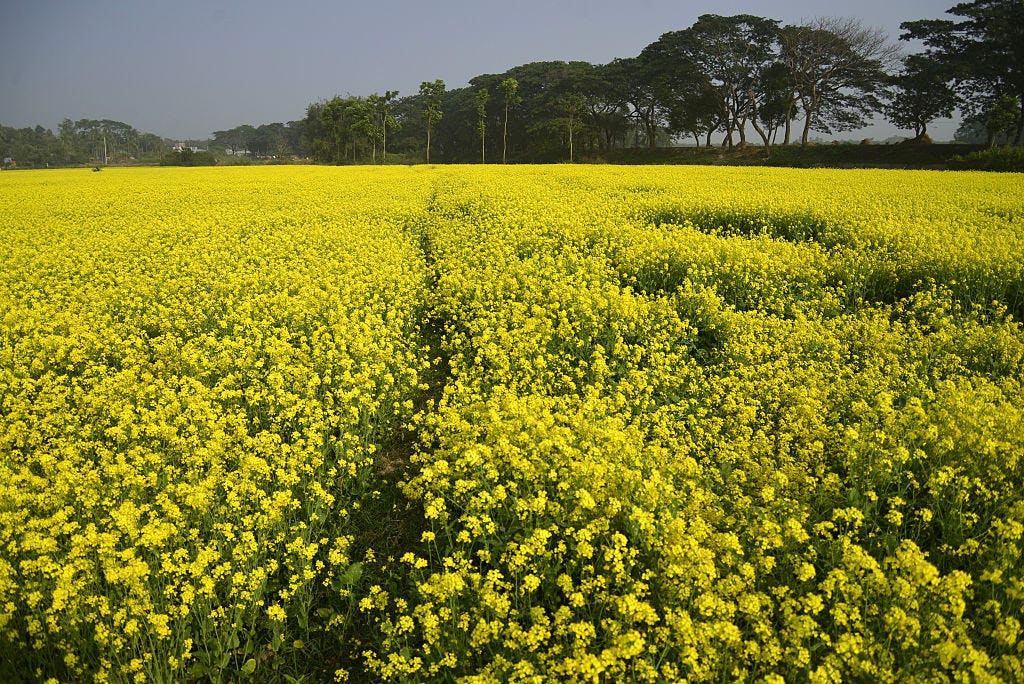Looking to add some zing to your plot? Mustard is a triple threat: Grow it for its zippy leaves, vibrant flowers, or pungent seeds. From fiery condiments to mellow greens—this cool-weather crop does it all.
Whether you’re team white mustard, brown mustard, or black mustard, these piquant plants are ready to bring the heat (or mild kick, depending on your preference) to your garden. Here’s your full guide to mustard plants, from seed to harvest.
Types of Mustard
Mustard plants are part of the brassicaceae family, which includes other cruciferous veggies like broccoli and cabbage. While there are over 40 species of mustard plants worldwide, here are the three main types:
- White Mustard (Sinapis alba): Also known as yellow mustard, this variety produces pale yellow to white seeds about 2-3 mm in size. It grows 1.2-1.5 meters tall and has a mild, slightly spicy flavor. White mustard is the primary type used to make mustard oil, paste, and flour.
- Brown mustard (Brassica juncea): This variety has smaller brown-reddish seeds 1-2mm in diameter. It has a more intense, pungent flavor compared to white mustard.
- Black Mustard (Brassica nigra): This variety produces the smallest seeds at 1-1.5 mm, ranging from gray to black in color. Black mustard has the most bitter and pungent flavor. It’s used to make spicy mustards but is less commonly cultivated due to difficulty in mechanical harvesting.
How Do You Plant Mustard?
Mustard plants come in three main varieties: brown, white (or yellow), and black. For beginners, start with white mustard—it’s the mildest and most common. Plant in the spring or fall when soil temperatures are above 40 degrees fahrenheit.
Because mustard prefers cool weather, a fall harvest usually produces better quality. For a fall harvest, count back 50 to 75 days from your first expected frost date. Space rows 12 inches apart for greens, or 2 to 3 feet for seed production. Plant seeds about ¼ to ½ inches deep, and, for a continuous supply, sow new seeds every 2-3 weeks. These cool-weather crops grow fast!
How Much Sunlight Do Mustard Plants Need?
Mustard plants love basking in full sun—aim for 6 to 8 hours of direct sunlight daily. If you’re growing tender baby greens, a bit of partial shade won’t hurt, especially when temperatures climb above 75 degrees fahrenheit. When it gets too hot, mustard plants will start to sulk—make sure to move to shade!
How Much Water Does a Mustard Plant Need?
If you stick your finger about an inch into the soil and it feels dry, it’s time to water—aim for about 1 inch per week. The soil should be consistently moist, but not waterlogged.
To avoid wet leaves, water at the base of the plant. Mulching with straw can help retain moisture and keep the soil cool.
What Kind of Soil Does a Mustard Plant Need?
Mustard plants prefer well-draining, loamy soil with a slightly acidic pH, below 6.0. They love soil rich in organic matter—if your soil is less than ideal, mix in some compost or other aged organic matter to give it some TLC. Your mustard plants will thank you with lush, flavorful growth.
Do Mustard Plants Need Fertilizer?
When seedlings reach 3-4 inches tall, it’s feeding time. Choose a nitrogen-rich fertilizer and feed every 4-6 weeks during the growing season. For organic gardeners, side-dress with compost or well-rotted manure.
Just remember that moderation is key—we’re aiming for flavorful, not overfed. Too much nitrogen can lead to all leaf and no flavor—not ideal for your mustard harvesting dreams.
Troubleshooting Tips
— Yellowing leaves? Check your watering—both over and under-watering can cause this.
— Holes in leaves? Look for flea beetles or cabbage worms. Use row covers for protection.
— Wilting despite moist soil? Check for root rot and improve drainage.
— Leggy plants? Ensure they’re getting enough light—at least 6 hours of direct sun daily.
— White, powdery spots on leaves? This could be powdery mildew. Improve air circulation and avoid overhead watering.
— Stunted growth? Your soil might need a nutrient boost. Try adding compost or a blanched fertilizer.
How Do You Harvest Mustard Greens?
For salads, harvest when the leaves are small, young, and tender—about 4 to 6 inches long. For cooking, allow the leaves to grow full size, but harvest before seed stalks form.
- Cut large outside leaves at the base, avoiding damage to the growing point
- Remove large leaves even if unused to make room for tender inner leaves
- Continue harvesting—leaves will regrow after cutting.
For best flavor, harvest after a light frost, which sweetens the greens. Consistent harvesting promotes continued growth.
How Do You Harvest Mustard Seeds?
To harvest mustard seeds, timing is crucial—careful monitoring ensures you catch them at the right moment before they disperse. Wait for the seed pods to turn from green to brown, and be sure to harvest them before they open.
- Cut off branches with mature seed pods or remove entire plants
- Spread an old sheet on the ground to catch falling seeds and pods
- Air-dry pods on a tray or fine screen for about 2 weeks
- Alternatively, place pods in paper bags and hang in a warm, dry place
- Pods are ready when completely dry and crispy
How Do You Process Mustard Seeds?
- Once husks are brown and dry, thresh to remove seeds.
- For small amounts, rub husks between palms over a large bowl
- Separate seeds from chaff
- Seeds can now be ground or used whole for making mustard.
Fun Facts
— Mustard plants can produce 1,000 pounds of seed per acre!
— In many cultures and religions, it’s believed that spreading mustard seeds around the house keeps evil spirits away.
— All parts of the mustard plant are edible, including leaves, seeds, and flowers.
Now go forth and let your garden get a little spicy!

Julia Cancilla is the engagement editor (and resident witch) at ELLE Decor, where she manages the brand’s social media presence and covers trends, lifestyle, and culture in the design world. Julia built her background at Inked magazine, where she grew their social media audiences by two million, conducted interviews with A-list celebrities, and penned feature articles focusing on pop culture, art and lifestyle. Over her five years of digital media experience, Julia has written about numerous topics, from fashion to astrology.







